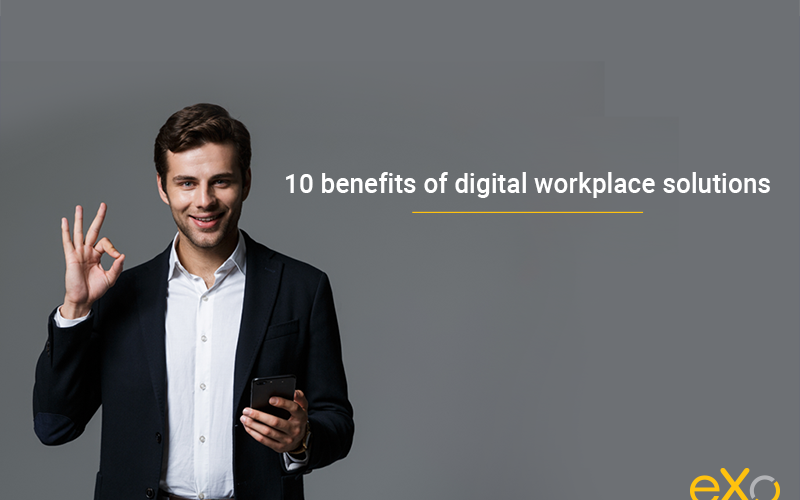- Fares Laroui
- February 18, 2021
10 Benefits of digital workplace solutions

Content
Although the choice depends entirely on unique business and team needs as well as the existing IT infrastructure, IT buyers and decision makers agree that digital workplace solutions are important. In fact, according to a research study conducted by CMSWire, 95% of respondents believe that a digital workplace is an important pillar of their digital transformation strategies. But what makes these solutions so appealing to businesses?
1. Create a robust corporate culture

FREE WHITE PAPER
Types of Digital workplace solutions
The modern workplace has evolved significantly in recent years, with advancements in technology, the growing number of tools …
2. Eliminate communication silos
3. Enhance the onboarding process
4. Boost productivity and performance
Second, depending on the collaborative and productivity tools that are already in place, digital workplace solutions can be thought of as the added communication and social layer that integrate all these apps together through APIs. For example, upon logging in, users can have a snapshot of the different apps they use within a tailored dashboard in their digital workplace homepage. This way they can have direct access to critical information and they won’t have to access every single third party application separately to get what they need.
5. Centralize access to business apps
As mentioned above, having too many separate apps in the workplace may lead to more harm than good in the long run.
According to Shane Malik, Senior Recruiter at Simpalm, “Having too many separate apps in the workplace may lead to more harm than good in the long run.”
engagement and performance
6. Increase revenue while reducing IT and operational costs
Another potential for revenue growth lays in the type of hosting: whether cloud or on-premise. Hosting on the cloud can help businesses significantly reduce IT costs related to maintenance and upgrades. With a revenue growth planning tool, you can keep track of your expenses and redirect excess budget to boost other aspects of your business. Although, it is worth noting that on-premise deployment has its fair share of advantages but it comes with IT cost and expertise.
7. Facilitate knowledge sharing and the exchange of expertise
8. Facilitate remote working
9. Engage and reward teams
10. Turn employees into brand ambassadors
tools and information
FAQ
You will find here Frequently Asked Questions about digital workplace with all the answers in one place.
What is a digital workplace?
- An evolution of the intranet
- A user centric digital experience
What are the digital workplace benefits?
Here are some of the benefits of digital workplace solutions:
- Create a robust corporate culture
- Eliminate communication silos
- Enhance the onboarding process
- Boost productivity and performance
- Centralize access to business apps
- Increase revenue while reducing IT and operational costs
- Facilitate knowledge sharing and the exchange of expertise
- Facilitate remote working
- Engage and reward teams
- Turn employees into brand ambassadors
How to launch an effective Digital Workplace?
- Understand users’ needs
- Identify your digital workplace ambassadors
- Build the digital workplace brand
- Training and onboarding
- Plan the big day
What does digital workplace really mean?
How to be a good digital workplace manager?
- Analytical skills and approach
- Focus on employees
- Communication and strategic vision
What are the common digital workplace challenges?
Here are 5 Challenges to a Digital Workplace and How to Overcome Them:
- Challenge #1: Develop a digital workplace governance model
- Challenge #2: Manage change
- Challenge #3: Low adoption rates
- Challenge #4: Find the perfect balance between UX and UI
- Challenge #5: A drop off in engagement over time
How do you secure your Digital Workplace?
Here are some best practices to minimise security threats in digital workplaces:
- Develop a cybersecurity policy
- Continuous training
- Control access to information
- Be sure to update regularly
Related posts
- All
- eXo
- Digital workplace
- Open source
- Internal communication
- Collaboration
- News
- intranet
- Future of work
- workplace
- Knowledge management
- Employee engagement
- Employee experience
- Employee productivity
- onboarding
- Employee recognition
- Change management
- Cartoon
- Digital transformation
- Infographic
- Remote work
- Tips & Tricks
- Tutorial
- Uncategorized
Leave a Reply
( Your e-mail address will not be published)


